 W
WFor the Summer and Winter Olympics, there are 27 venues that have been or will be used for figure skating. This is one of two sports in the Winter Olympics to debut in the Summer Olympics with ice hockey being the other. The first venue for the event took place during the 1908 Games was held indoors. Twelve years later, the venue joined ice hockey as another Winter Olympic sport in the Summer Olympics. For the first two Winter Olympics, figure skating was held outdoors. With figure skating being held outdoors, there were weather concerns with thawing for the first two Winter Games. A suggestion by International Olympic Committee President Count Henri de Baillet-Latour to 1932 Olympic Organizing Committee President Godfrey Dewey in September 1930 led Dewey to create the first indoor arena for the Winter Olympics. For the 1936 Games, the venue was covered partially. Following World War II, the 1948 venue became the first venue to be used twice at the Winter Olympics since it had been used twenty years earlier. Figure skating's final competition that took place outdoors was in 1956 though that venue has since had a roof added to it. Since 1960, all figure skating competitions have taken place indoors. Three National Hockey League (NHL) venues have hosted Olympic figure skating competitions: the 1988 and the 2010 though the NHL Vancouver Canucks moved out of the 2010 venue following the 1994–95 season. The 2002 venue was a National Basketball Association (NBA) venue which meant the Utah Jazz was on a road trip during the 2002 Games.
 W
WBislett Stadium is a sports stadium in Oslo, Norway. Bislett is Norway's most well known sports arena internationally, with 15 speed skating world records and more than 50 track and field world records having been set here. The original stadium was demolished in 2004 and construction of a new stadium was completed by the summer of 2005. The New Bislett Stadium was designed by C.F. Møller Architects.
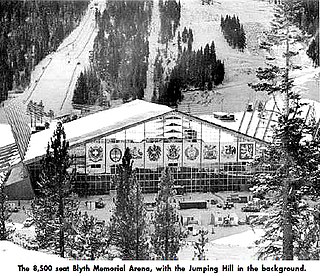 W
WBlyth Arena was an ice skating arena in the western United States, located at Squaw Valley, California. It was built in 1959 as venue for ice hockey, figure skating competitions, and the opening and closing ceremonies of the 1960 Winter Olympics. With a seating capacity of 8,500, standing-room crowds of 10,000 were reported for the hockey games between the U.S. and the Soviet Union and the U.S.-Czechoslovakia game during the final day. The elevation of the rink was 6,200 feet (1,890 m) above sea level.
 W
WThe Capital Indoor Stadium is an indoor arena in 56 Zhongguancun South Street, Beijing, China that was built in 1968. It hosted matches between national table tennis teams of China and the United States in 1971; these matches were part of the exchange program known as ping pong diplomacy.
 W
WCC Amfi, also known as Nordlyshallen, is an indoor sports arena in Hamar, Norway. It is mostly used for ice hockey and is the home arena of Storhamar Hockey. It has also been used for short track speed skating, figure skating, handball, events and concerts. The venue has a capacity for 7,000 spectators and was built for the 1994 Winter Olympics, where it was used for short track speed skating and figure skating. Other major events held at the arena include the 1999 IIHF World Championship in ice hockey, the 1999 World Women's Handball Championship, the 2012 IPC Ice Sledge Hockey World Championships and the 2016 Winter Youth Olympics.
 W
WThe Herb Brooks Arena is a multi-purpose arena in Lake Placid, New York. This surface, along with the USA Rink, was built for the 1980 Winter Olympics.
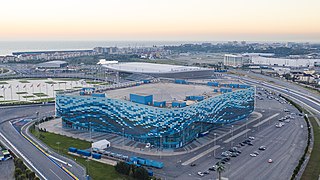 W
WThe Iceberg Skating Palace is a 12,000-seat multi-purpose arena at Sochi Olympic Park in Sochi, Russia. The venue hosted the figure skating and short track speed skating events at the 2014 Winter Olympics. It cost $43.9 million, including the temporary works for the Olympics. 15,000 tonnes of steel were used. The environment was taken into consideration in its construction. A local figure skating competition was held in October 2012 but the International Skating Union said more work was needed to be ready for the 2012–2013 Grand Prix of Figure Skating Final, a test event in December 2012. At the Grand Prix Final, competitors said they liked the venue but some spectators complained about handrails obstructing the view in the upper tier. It takes about two hours to adjust the ice when switching from figure skating to short track or vice versa.
 W
WHalle Olympique is an indoor arena located in Albertville, France. For the 1992 Winter Olympics, it hosted the figure skating and the short track speed skating events. It was first use for the 1991 Trophée Lalique, which was staged as a test event for the Olympics. The venue also hosted selected matches of the 2017 World Men's Handball Championship.
 W
WMakomanai Sekisui Heim Ice Arena (真駒内セキスイハイム アイスアリーナ) is an indoor ice skating arena in Minami-ku, Sapporo, Japan. It was built in December, 1970, holds 11,500 people, and has an area of 10,133 m² in total. The figure skating and some of the ice hockey games and the closing ceremonies from the 1972 Winter Olympics were held at this arena.
 W
WThe Sapporo Mikaho Gymnasium is an indoor sporting arena in Higashi-ku, Sapporo, Hokkaido, Japan.
 W
WOlympiahalle is an indoor sports venue located in Innsbruck, Austria. During the 1964 Winter Olympics, it hosted the figure skating and ice hockey events. Twelve years later, at the 1976 Winter Olympics, it again hosted figure skating and ice hockey.
 W
WThe Pacific Coliseum, known to locals as "The Coliseum" or the "Rink on Renfrew," is an indoor arena located at Hastings Park in Vancouver, British Columbia. Its main use has been for ice hockey and the arena has been the home for several ice hockey teams.
 W
WThe Palais de Glace d'Anvers was a sports venue located in Antwerp, Belgium. Measuring 168 feet (51 m) long by 58.5 feet (17.8 m) wide, it hosted both the figure skating and ice hockey events for the 1920 Summer Olympics. The building was demolished in 2016.
 W
WPalais des Sports, known also as the Palais des sports Pierre Mendes or "Le Stade Olympique de Glace" is an indoor ice hockey arena, located in Paul Mistral Park in Grenoble, France. The vaulted roof structure was built from November 1966 to April 1967, therefore having tough weather problems to add to construction difficulties. The stadium was conceived for the Olympiques Winter Games held in Grenoble in 1968 and has a capacity of up to 12,000 spectators.
 W
WPrince's Skating Club was an ice rink in the Knightsbridge area of London, England. It saw a number of firsts for ice hockey in Britain and Europe.
 W
WScotiabank Saddledome is a multi-use indoor arena in Calgary, Alberta, Canada. Located in Stampede Park in the southeast end of downtown Calgary, the Saddledome was built in 1983 to replace the Stampede Corral as the home of the Calgary Flames of the National Hockey League, and to host ice hockey and figure skating at the 1988 Winter Olympics.
 W
WSkenderija is a cultural, sports and trade center located in Sarajevo, Bosnia and Herzegovina.
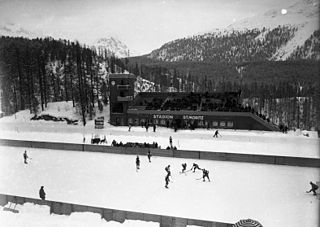 W
WSt. Moritz Olympic Ice Rink is an outdoor stadium in St. Moritz, Switzerland. It was the venue for the ice hockey, speedskating and figure skating events, as well as the location of the opening and closing ceremonies at the 1928 Winter Olympics and 1948 Winter Olympics.
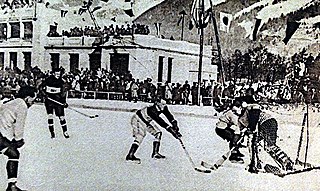 W
WStade Olympique de Chamonix is an equestrian stadium in Chamonix, France. It hosted the opening and closing ceremonies to the 1924 Winter Olympics along with cross-country skiing, curling, figure skating, ice hockey, military patrol, the cross-country skiing part of the Nordic combined, and the speed skating events. The stadium holds 45,000.
 W
WStadio Olimpico del Ghiaccio was built between 1952 and 1954, primarily as an open air Figure skating arena in Cortina d'Ampezzo, Italy, to hold between seven and eight thousand spectators, with the possibility of making temporary arrangements to accommodate twelve to fifteen thousand for the period of the Olympics. The venue was inaugurated on 26 October 1955. During the 1956 Winter Olympics, the arena held the opening and closing ceremonies, the figure skating events and select ice hockey games. Sometime after 1981, a roof was added to the structure. The stadium will host curling in the 2026 Winter Olympics and it will also host wheelchair curling in the 2026 Winter Paralympics.
 W
WThe Stampede Corral was a multi-purpose venue in Calgary, Alberta, Canada. Located on the grounds of Stampede Park, the arena was completed in 1950 at a cost of C$1.25 million to replace Victoria Arena as the home of the Calgary Stampeders minor professional hockey club, which hosted their Western Hockey League games for years. The Corral was built and is still owned by the not-for-profit Calgary Exhibition & Stampede organization, which leases the underlying land at $1/year from the city of Calgary. Seating 6,475, plus standing room, it was used during the annual Calgary Stampede, with a variety of entertainment events in each year's daily ENMAX Corral Show.
 W
WPalavela, formerly known as Palazzo delle Mostre and Palazzo a Vela is an indoor arena that is located in Turin, Italy, on the bank of the River Po. It was designed by engineer Franco Levi and architects Annibale and Giorgio Rigotti. The arena is 130 metres in diameter. The Palavela was featured in the 1969 film The Italian Job. In a famous scene in the film, three Minis are seen driving onto and over the arena's distinctive roof. It has a seating capacity for a maximum 12,200 people, and 9,200 when configured for basketball games.
 W
WVivint Arena is an indoor arena located in Salt Lake City, Utah. The arena serves as the home venue for the National Basketball Association (NBA)'s Utah Jazz, and has been the home venue for other professional athletic teams, such as the Arena Football League's Utah Blaze and the Women's National Basketball Association (WNBA)'s Utah Starzz. It seats 18,306 for basketball, has 56 luxury suites, and 668 club seats.
 W
WThe White Ring is an indoor sporting arena located in Nagano, Japan. The capacity of the arena is 7,000 people.
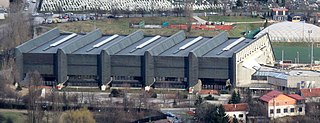 W
WThe Juan Antonio Samaranch Olympic Hall is an indoor multi-purpose arena in Sarajevo, Bosnia and Herzegovina. Named in honor of Juan Antonio Samaranch in 2010 after his death, it was used for various sporting events at the 1984 Winter Olympics, and as the main venue of the 2019 European Youth Olympic Winter Festival.